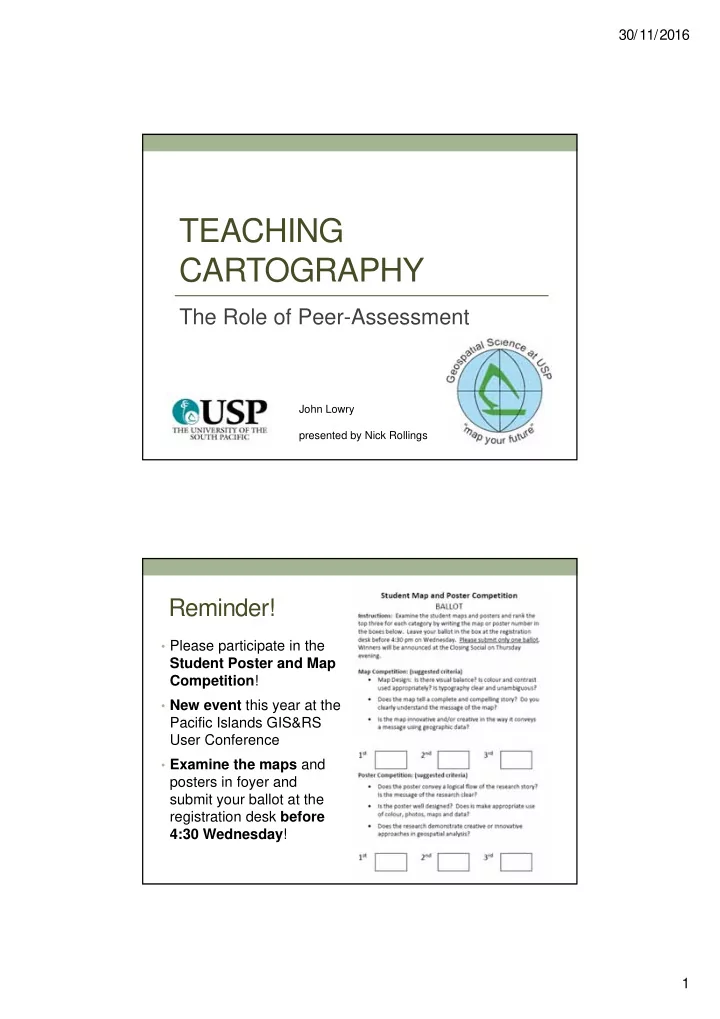

30/11/2016 TEACHING CARTOGRAPHY The Role of Peer-Assessment John Lowry presented by Nick Rollings Reminder! • Please participate in the Student Poster and Map Competition ! • New event this year at the Pacific Islands GIS&RS User Conference • Examine the maps and posters in foyer and submit your ballot at the registration desk before 4:30 Wednesday ! 1
30/11/2016 Objectives of this presentation • Rationale and Peer-Assessment approach in GS231— Cartography and Geovisualization • Examples of draft and final maps (after peer-assessment) • Results of student survey of Peer- Assessment in GS231 this semester • Concluding observations & feedback Peer Assessment and GS231 • Peer Assessment pedagogy • Common in many disciplines • Students evaluate the work of peers • Students generate discussion (or provide feedback) • Moderated at some level by the instructor • Cartography: • Involves applying principles best learnt by doing & mimicking • Like art, good cartography evolves through an iterative process of refinement 2
30/11/2016 GS231 Assessment Structure • 8 mapping assignments each covering different cartographic techniques or principles • Each assignment: Student submit draft map � randomly assigned two peers’ maps to assess � based on feedback student completes final map for marking by instructor. Initial draft map Assessment Refinement (1 week) Phase (1 week) Phase (1 week) Final Submitted Assignment Draft Peer Marks given Given submitted feedback by Instructor Map Assignment 1 • Theory: • Cartographic Design Principles (Visual Hierarchy, Contrast, Figure-Ground, Visual Balance, Focus and Attention, Alignment and Positioning) • Technical Skills (ArcMap & QGIS): • Data frames, map scale, map elements, manipulate layers, symbology, alignment tools • Following are Draft and Final map for the same student . 3
30/11/2016 Map Assignment 1: Layout and Design DRAFT FINAL Map Assignment 2: Principles of Colour • Theory: • RGB and CMYK colour models, Concepts and uses of Hue , Saturation and Value (HSV) • Technical Skills (ArcMap & QGIS): • Creating a colour map file in ArcGIS and QGIS 4
30/11/2016 Map Assignment 2: Principles of Colour DRAFT FINAL Map Assignment 3: Typography • Theory: • Typographic guidelines , positioning rules, fonts, character and word spacing, leading • Technical Skills: • Annotation (geodatabase) 5
30/11/2016 Map Assignment 3: Typography Guidelines DRAFT FINAL Map Assign. 4: Large Scale Reference • Theory: • Concepts of scale and generalization • Technical Skills (ArcMap): • Screen digitizing data for a large scale map 6
30/11/2016 Map Assignment 4: Large Scale Reference Maps DRAFT FINAL Map Assign. 4: Quantitative Data • Theory: • Concepts of count and continuous data, rates and ratios; Choropleth mapping • Technical Skills (ArcMap): • Download data from web (PopGIS), convert count to ratios, Calculate percent change . 7
30/11/2016 Map Assignment 5: Mapping Quantitative Data DRAFT FINAL Other lab assignments • Cartograms (ArcGIS Cartogram extension) • Data Driven Pages (ArcGIS) • Web-based mapping (ArcGIS Online) 8
30/11/2016 Student Questionnaire • Anonymous responses • Focused on peer-assessment process • Given at the end of the semester Doing the peer assessment helped me better understand things we learned about in lecture (e.g. principles of colour, good map design, etc.) • Students recognized the link between lab and lecture . 9
30/11/2016 After I assessed other students’ maps I often reflected on how I could improve my own map. • Looking at other students’ maps motivated self reflection Most of the time my peers gave a thoughtful, honest assessment of my maps. • There was a problem that some students did not do the peer assessments which left other students frustrated. 10
30/11/2016 Sometimes I did not assess my peers’ maps because: • Reasons for not assessing peer’s maps varied. The process of completing a draft map, then assessing peers’ maps, then finalizing my draft map took too long. • The process: Draft > Peer Assessment > Final often took 3 weeks, which may have been too long. 11
30/11/2016 My final map was usually greatly improved compared to my draft map. • Students recognized their maps were improved compared to drafts Instead of doing peer-assessment, it would have been better if assessments/critiques of the lab assignments were done by a Teaching Assistant. • About half the class saw the value in doing the assessment. The other half apparently did not. 12
30/11/2016 Conclusions • In general, students seemed to recognize the value of the peer assessment process • Some students often did not do the peer assessment ; this caused some frustration • Students valued the input from their peers as they felt it helped improve their maps • There were 7 peer assessments. Next year there may only be 5 . • Feedback from the audience on ideas for improvement is welcome! Vinaka! 13
Recommend
More recommend